6 Types of Woodpeckers in Ohio (with Pictures)
Last Updated on
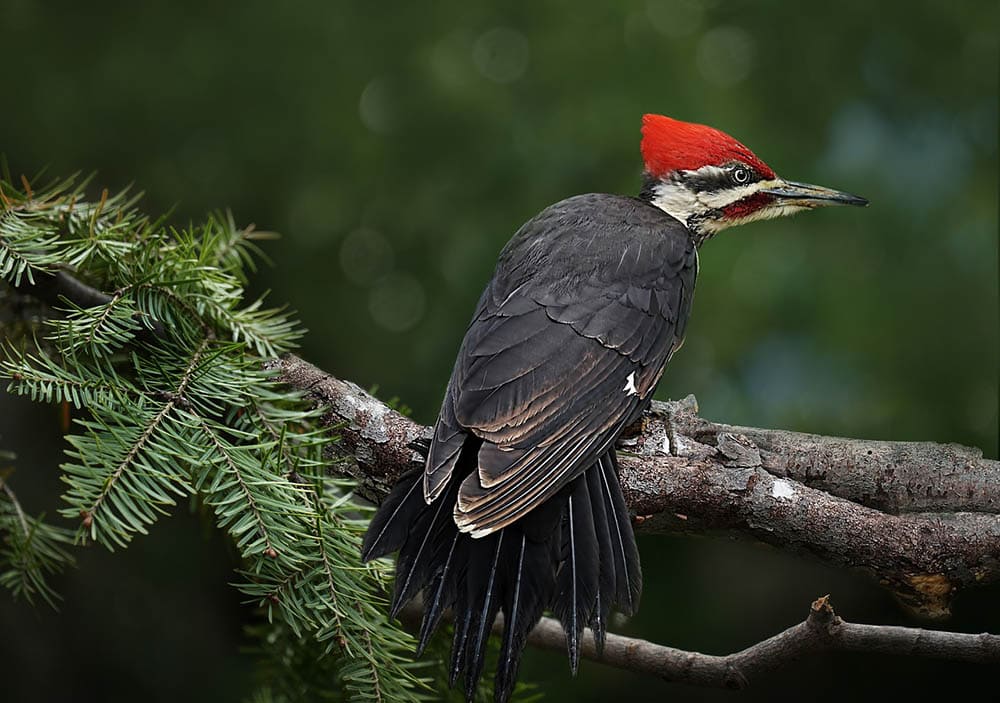
Ohio is home to some pretty exciting forms of wildlife. Among them, several different species of woodpecker dwell. But exactly which species of woodpeckers make their home in the Buckeye State? Surprisingly, more than you might think—and some you might not have seen yet.
You’re in luck. We have visual images for all six woodpeckers and a series of information about each. So, next time you spot or hear one out in nature, you’ll be able to identify them.

The 6 Types of Woodpeckers in Ohio
1. Downy Woodpecker
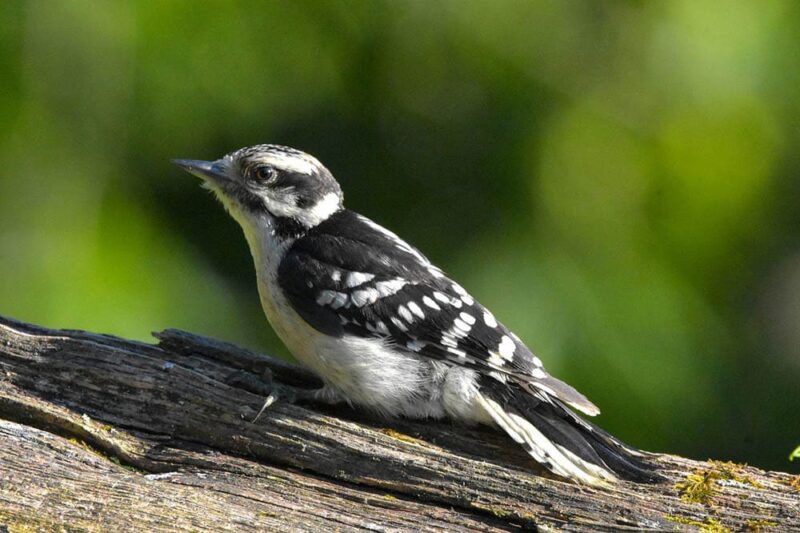
The Downy woodpecker is the smallest woodpecker species in America—and they just so happen to love Ohio’s climate. These tiny cuties might be less noticeable than their other woodpecker cousins, but what they lack in size, they make up for with interesting lifestyles and an adorable appearance.
Appearance
Males and females are sexually dimorphic, but you have to pay close attention to be able to tell the difference. The differences are less noticeable than in some other bird breeds.
Males typically have more white on their feathers, with a red spot on the back of their head, while females lack this red marking. Both sexes are very small, making them incredibly agile.
Habitat
The downy woodpecker finds solace in many different locations. This bird happily makes its home in thin woodlands, bushy meadows, and even populated spaces.
Because of their tiny size, they can maneuver easily, going up and down tree trunks with no issue. This helps them snack on tons of insects and larva.
2. Red-headed Woodpecker
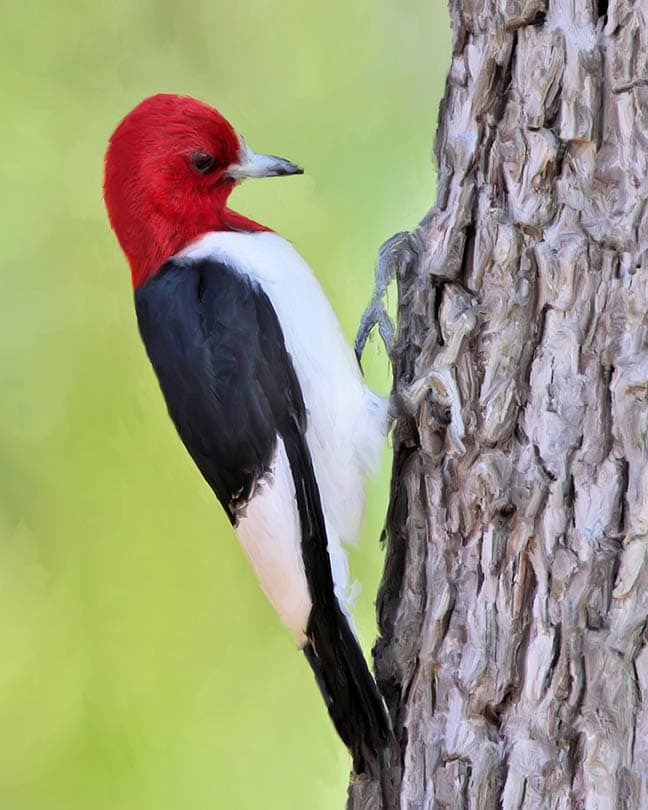
The Red-headed woodpecker might be one of the more common species you would recognize in Ohio. These woodpeckers might not be very prevalent, but they are one of the noisiest in the state.
Sadly, while it is one of the most recognizable woodpeckers you might see in Ohio, it’s also one of the rarest. This bird used to be very abundant in numbers but has since taken a drastic decline. So, if you do see one of these woodpeckers in its natural habitat, know that you are a lucky duck.
Appearance
Their bodies are a combination of white and black. As its name implies, the head of the Red-headed woodpecker is cherry red. However, before it reaches adulthood, they are much duller in color, having grayish-brown heads.
Unlike some other species, these woodpeckers have tons of white on their front and wings.
Habitat
The Red-headed woodpecker does not love thick forests. They much prefer open spaces and thinly wooded areas to utilize their hunting skills. It’s also useful for keeping themselves protected from predators.
The sneaky woodpeckers hide in trees waiting for opportunistic moments. Even though they are larger, it doesn’t deter them from moving with grace and agility. It is not unusual to see a Red-headed woodpecker snatch a bug out of the air as it flies.
3. Red-bellied Woodpecker
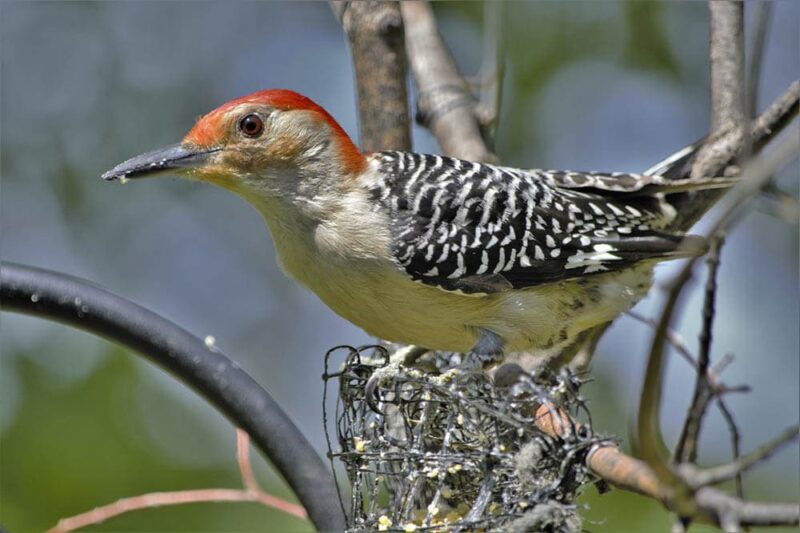
The Red-bellied woodpecker is a medium-sized bird that is semi-prevalent in Ohio. They might not be as common as others on our list, but still, your chances of seeing them at some point in your life if you live in Ohio are pretty good.
These birds have a very distinct call. So, once you’re familiar with the sound that they make, you’ll be able to locate them long before you can actually see them.
Appearance
The Red-bellied woodpecker is actually quite pale with black-barred markings on his back despite its name. Males and females are sort of tricky to tell apart because they both have red markings on their heads.
However, the male’s red markings are much more prominent, encompassing the entire base of his head and reaching slightly down his neck. The females only have a fraction of that red coloring.
Habitat
While the Red-bellied woodpecker does like seclusion, they can sometimes be seen in residential areas—especially if you have the right environment to lure them in.
But most of the time, they make their homes in swamps and along riversides where food is plentiful and the environment is peaceful.
4. Hairy Woodpecker
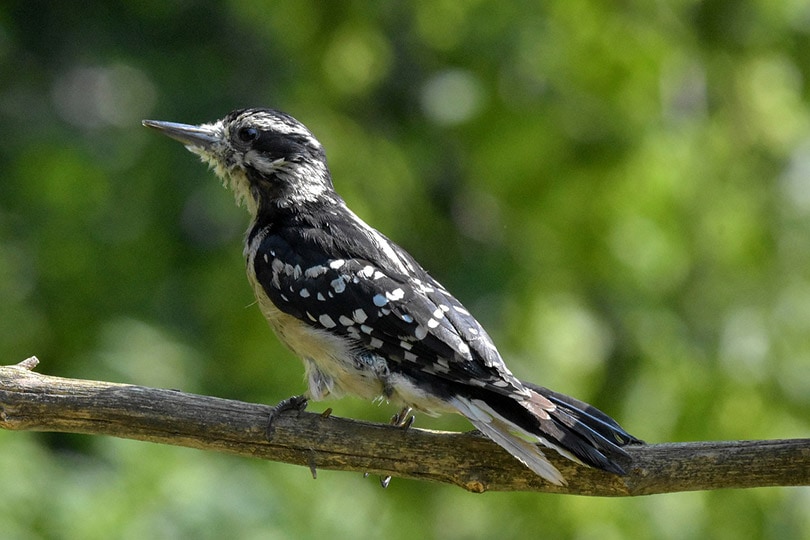
The Hairy woodpecker is a brilliant-looking medium-sized bird. While they might be hard to spot in the wild, they are a very prevalent species in North America.
These birds are often confused with their Downy cousins because of their similar appearance and noises.
Appearance
Despite its name, the Hairy woodpecker really doesn’t look much hairier than any other woodpecker at first glance. But if you’re lucky enough to get close, this name was given to them due to their hairlike feathering on the back.
However, it touts a stunning black and white pattern that makes them stand apart from their other woodpecker cousins.
Habitat
The Hairy woodpecker has quite an impressive range, able to withstand high mountains and sea-level areas alike. These birds are often seen where downy woodpeckers also live.
These birds have a shrill peek call that is quite noticeable if you know what to listen for. You might notice their bold black bodies and white patterns moving up and down tree trunks, searching for food.
5. Northern Flicker

The Northern Flicker might be one of the most interesting on our list because it differs from its other woodpecker family members. While body structure is similar, they have many different patterns and habits than their wood-drilling cousins.
These are rare in Ohio, so it’s a real spectacle when one pops up for the human eye. But if you do get the opportunity to see one of these lovely woodpeckers in their natural habitat, be sure to have your camera ready!
Appearance
These stunning beauties have quite a presence, decorated in beautiful dark spots and tawny feathering.
Males and females differ slightly, as the males tend to be more colorful than the females. However, they’re mostly neutral colors with dotted patterns.
Habitat
Interestingly, the Northern Flicker loves to pluck insects out of the ground. So, instead of spending tireless hours working away at wood, they realize just how easy soil is to dig with their sharp beaks.
While you might see a Red-headed woodpecker drilling away the tree, Northern Flickers will be turning up the soil to see what goodies they can find inside. You are more likely to see this woodpecker on the ground than in the branches.
6. Pileated Woodpecker

The Pileated woodpecker is definitely the largest on our list. But when you see it, you’ll know. You can hear the Pileated woodpecker doing their business far away, and they can be quite noisy neighbors if they take interest in your backyard tree.
These woodpeckers have been known to do some damage. Theycan put massive holes in trees that can, in turn, kill them. Some tree owners do not want these types of woodpeckers lingering around their property because of that.
However, most of the time, the Pileated woodpecker targets trees that are standing but already dead or fallen logs.
Appearance
The Pileated woodpecker is definitely a sight to behold. These woodpeckers have very sleek feathering with a fascinating hairdo that looks funky.
Both males and females have a bright red crest, but males have an additional red stripe on their cheek.
Habitat
Suppose you’re walking leisurely through a wooded area and notice a giant pile of wood chips at the base of a tree. In that case, we might be able to spot the Pileated woodpecker. Once these relentless birds pick a good tree that provides them with lots of sustenance, they sometimes snack on it for an entire season.
Despite their destruction potential, they also get rid of many insects that are otherwise harming trees. So, there is balance in the equation.

In Conclusion
Seeing a woodpecker is really a fascinating thing. Now next time you hear that loud knocking at the tree or hear a particular call, you might be able to identify exactly the type of woodpecker you can hear or see.
These beautiful creatures deserve recognition, so the next time you are with a friend and see a woodpecker, be sure to bestow onto them the knowledge that you now have—you know you want to!
Featured Image Credit: MiniMe-70, Pixabay
About the Author Ashley Bates
Ashley Bates is animal writer and enthusiast who is currently studying the art of animal therapy. A mother to four human children— and 23 furry and feathery kids, too – Ashley volunteers at local shelters, advocates for animal well-being, and rescues every creature she finds. Ashley's mission is to create awareness and education about animals of all shapes and sizes to promote proper care and respect.
Related Articles:
Monocular vs Telescope: Differences Explained (With Pictures)
10 Types of Hummingbirds in Arkansas (With Pictures)
8 Types of Hummingbirds in Nebraska (With Pictures)
5 Types of Hummingbirds in Idaho (With Pictures)
3 Types of Hummingbirds in Mississippi (With Pictures)
8 Types of Hummingbirds in Kansas (With Pictures)
5 Types of Hummingbirds in West Virginia (With Pictures)
5 Types of Hummingbirds in Ohio (With Pictures)
